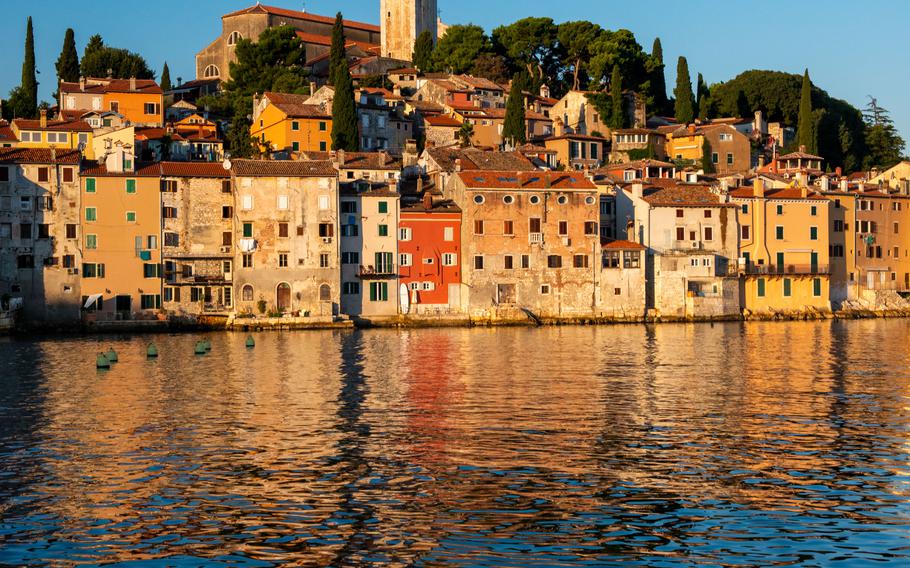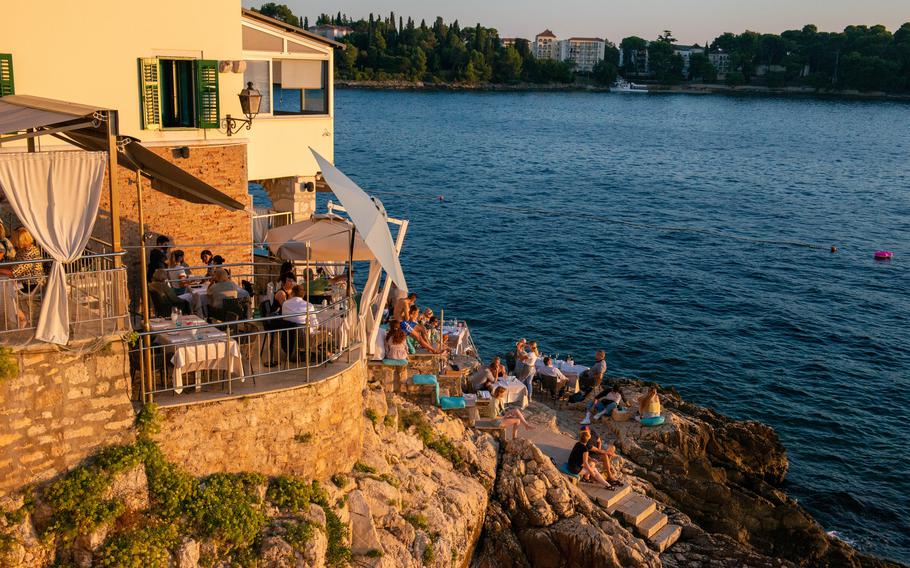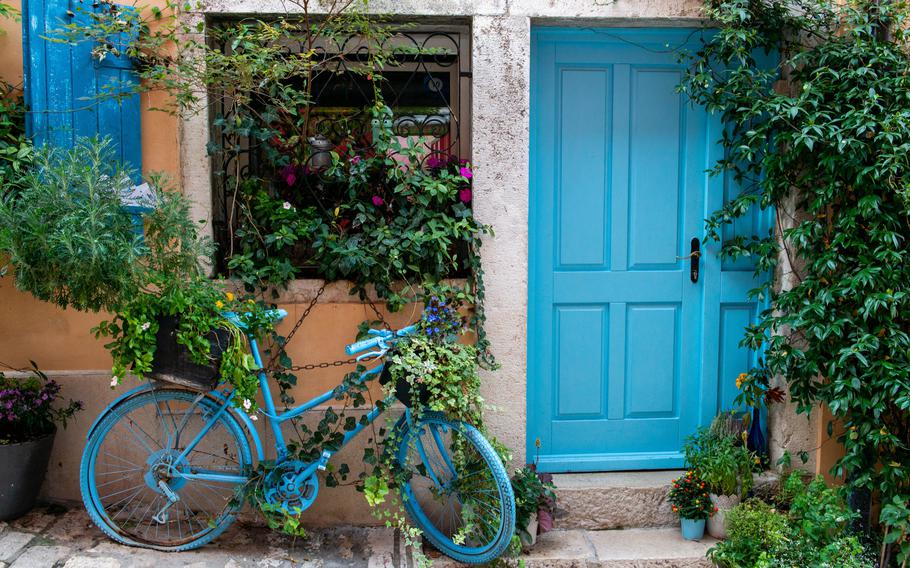
The bell tower of the Church of St. Euphemia in Rovinj resembles the bell tower of St. Mark’s Basilica in Venice. (Anna Mazurek/The Washington Post)
The smell of truffles lingered in the air as I wandered up the steep cobbled streets toward the ramparts that lined the edges of Motovun, a fortified medieval hill town on the Istria peninsula in northwestern Croatia. The view was stunning; the green, rolling hills were dotted with vineyards, olive groves and forests, the source of the truffles.
It was the second day of my September visit to Istria - my first international trip in 17 months - and it had already exceeded my expectations. I was fully vaccinated and eager to celebrate my 40th birthday abroad by joining a friend who lives in Croatia to explore the country known for its picturesque coastline and ancient walled cities.
Our first stop in Motovun was the restaurant across the street from our Airbnb: the inviting stone terrace of Konoba Mondo. I ordered a delicious penne with Sicilian pistachio and Istrian prsut, an air-cured ham. After one bite, my friend exclaimed that the creamy polenta with Parmesan cheese and black truffles that she ordered was the best meal of her life.
"Istria cuisine is very much like Italian but heavier," says Konoba Mondo owner Klaudio Ivasić, who uses his grandmother's recipes and still lives about 65 feet down the street, in his childhood home. He says the key ingredients are homemade pasta, polenta, Mediterranean spices such as laurel and rosemary, and the famous truffles, which are sourced from the forests around Motovun and the nearby towns of Buzet and Livade.
The regional cuisine also features some unique local pasta such as fusi, a flat, square noodle rolled up to almost resemble penne, and pljukanci, which are short, thick, twisted noodles. Pasta dishes are often served with prsut, boskarin (beef from local longhorn cattle), wild asparagus and seafood in coastal areas. Another integral part of the cuisine is wine, which is most often made with Teran (red) or Malvazija (white) grapes.
Because Motovun is tiny, we spent our days exploring the peninsula's interior and narrow, winding roads by car. Although every hill appeared to be topped with a medieval town or an abandoned castle, I never tired of either. We wandered the ruins of Pietrapelosa castle; the streets of Hum, the self-proclaimed smallest town in the world; and Dvigrad, Istria's largest complex of medieval ruins, which were destroyed by multiple sieges and the plague. In between sights, we snuck in an olive oil and wine tasting at Ipsa, a family-owned business with a shaded patio overlooking the vineyards, and learned about Istria's complex identity.
When I arrived at sunrise to photograph the city of Rovinj, for example, the scene could have been mistaken for Venice. I set up my tripod and waited for the sun to highlight the Italian bell tower on a hill above a row of colorful buildings lining the water. The likeness to Venice (if I had removed the hill and added some gondolas) was not a coincidence; the Republic of Venice ruled this coastal town for five centuries.
After the Venetian rule ended in the 18th century, its influence remained in the architecture and culture. The winged lion of St. Mark, the emblem for the Venetian Republic, was a common sight in Rovinj and across the peninsula. The cobbled streets and laundry lines strung from balconies made me nostalgic for Venice, which I visited as a college student in the early 2000s, on my first trip to Europe - a trip that would later ignite a life and career of travel. Two decades later, I wandered the streets of Rovinj in the same state of awe at the elaborate architecture, clicking my camera's shutter at every corner.
Aside from architecture, the other element Rovinj shares with Venice is the crowds; the streets were packed with tourists and vendors selling paintings and other trinkets. Every cafe was overflowing at sunset. I had naively thought that, by traveling after peak season, I would miss the crowds. Because Croatia is open to travelers who meet either vaccination or testing requirements, this wasn't the case. As an added safety precaution, I dined only outdoors and wore a mask indoors and focused on outdoor attractions.
In addition to the Venetians, the Romans, Byzantines, Slavs and Austrians ruled Istria at times, as they did much of Croatia's coast. The only exception was after World War I, when Istria became part of Italy while the majority of modern-day Croatia became part of Yugoslavia. It joined Yugoslavia after World War II.
For a deeper look into the region's tangled history, I reached out to Wollfy Krasić, assistant professor for the Department of Demography and Croatian Emigration at the University of Zagreb.
"Istria today undoubtedly has a Croatian identity but also a strong regional identity, which is due to the fact that, although the Croatian population was numerically predominant in Istria for centuries, Istria was not part of the Croatian state (as part of communist Yugoslavia) until the end of the World War II," Krasić wrote via email. "As for the most famous cultural monuments, they were created in the Roman, Byzantine and Venetian periods, although there are exceptions."
The Italian heritage is an integral part of regional culture. Krasić points out that seven towns and 12 municipalities in Istria County are officially bilingual, which means "not only bilingual street signs or the presence of schools where the language of instruction is Italian, but also the translation into Italian of all official documents of the local administration."
I frequently spotted these bilingual street signs in small hill towns such as Groznjan and in Pula, Istria County's largest city. The road signs along major highways were also in both languages. One of the most interesting examples of this heritage was in the center of Pula, an important outpost of the Roman Empire known for an amphitheater built during the same time frame as the Colosseum in Rome. Forum Square, which has served as the town's main square since the reign of the Roman Empire, features the crumbling Temple of Augustus, built during the rule of Augustus Caesar. The temple stands beside the medieval town hall that flies the flags of Istria, Croatia, the European Union and Italy - a visual representation of Istria's identity.
I spent my last night in Istria pondering the complexities of the region while hunting for the perfect dinner spot in Rovinj. My friend had left earlier in the day to return to the southern Croatian city of Split, and I managed to snag a seat for one at the last minute at La Puntulina, a Michelin Guide-listed restaurant. Its photogenic terrace, which spreads across the rocks along the water's edge, is the most coveted dinner spot in town. The fusi pasta with boskarin was one of the best meals of my trip.

La Puntulina is a Michelin-Guide listed restaurant in Rovinj, Croatia, famous for its terrace, which covers the rocks along the waterfront. (Anna Mazurek)
Although the historic influences are obvious, Istria, like the rest of Croatia, has a distinctive culture apparent in everything, including the food, the wine and the extremely friendly and welcoming people - such as the determined hostess who set up a makeshift table for me with a perfect sunset view at La Puntulina. As the sun slipped slowly into the clear blue water, I sipped on a chilled glass of Teran - a dry red wine - happy to be traveling again despite the crowds and already looking forward to a return trip to Croatia.

A colorful doorway in the old city of Rovinj. (Anna Mazurek/The Washington Post)
IF YOU GO
Where to eat
Konoba Mondo
Barbican ul. 1, Motovun
011-385-52-681-791
A locally owned restaurant in central Motovun with a large patio that serves a variety of pasta, meat and truffle-inspired dishes. The owner grew up about 65 feet down the street and uses his grandmother's recipes. Open daily noon to 3 p.m. and 6 to 10 p.m.; closed Tuesday. Entrees about $12 to $26.
La Puntulina
Ul. Sv. Kriza 38, Rovinj-Rovigno
011-385-52-813-186
La Puntulina is a Michelin Guide-listed restaurant on the water. The terrace, which spreads across the rocks, is a popular sunset spot. Reservations are recommended. Open daily 1 p.m. to midnight; closed Wednesday. About $17 to about $39.
Ipsa
Ipsi 10, Livade
011-385-91-2060-538
Located in the small village of Ipsi and surrounded by olive groves, this family-owned estate produces both wine and olive oil. Open daily 11 a.m. to 4 p.m. in winter and 10 a.m. to 6 p.m. in summer. Tastings free.
Information: istra.hr/en